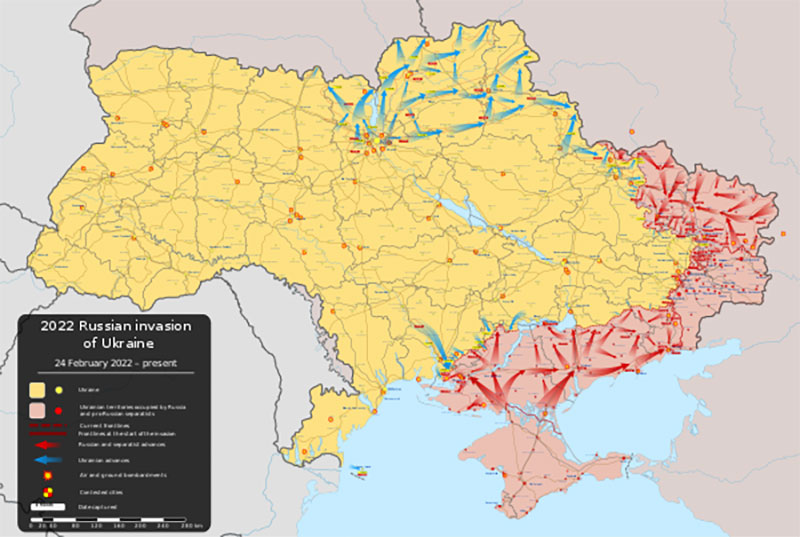
According to military consultant, retired Army Colonel Douglas MacGregor, on Friday, September 2, the Biden Administration asked Congress for another $11.7 billion in aid to support Ukraine in its war with Russia. $4.5 billion of this is for budgetary support of the Ukrainian government. Another $4.5 billion is to replace military equipment stockpiles being transferred by US Armed Forces to Ukraine. $2.7 billion is for defense and intelligence aid for Ukraine. The US continues to be the principal provider of military, financial, and intelligence aid to Ukraine. A substantial part of the military aid will be HIMARS multiple rocket launchers, M777 Howitzer artillery guns, and combat drones.
According to MacGregor and former Marine officer and State Department official, Scott Ritter, the recent Ukrainian counterattack on Kherson has failed, with three Ukrainian brigades suffering heavy casualties. Many Ukrainian soldiers were hospitalized in Mykolaiv (Russian, Nikolaev).
Ritter also believes the US cost to operate the Ukrainian government is about 5.0 billion per month and that US military weapons and ammunition have been drawn down to levels weakening desired levels of US military preparedness. NATO allied shipping of military supplies to Ukraine has slowed down considerably in the last month. Sweden, however, has stepped up arms supplies to Ukraine.
Also according to MacGregor, all Ukrainian war correspondents have been recalled from the front. The Ukrainian government has imposed new censorship guidelines on Ukrainian journalists. Journalists are forbidden to evaluate the actions of the Ukrainian Armed Forces. Only top military leadership may report on the course of hostilities. It is forbidden to contradict official interpretations of military situations. Predictions are also prohibited. Only high ranking Ukrainian Armed Forces officers may report on military actions, their consequences, and results. This has been further confirmed by Rob Lee, a senior fellow at the Foreign Policy Research Institute (FPRI) who often writes for the dissident Russian anti-war Meduza newsletter and website.
Again, I advise readers that all war information is subject to emotional bias, distortion, exaggeration, and perpetrated deception. There are propaganda fronts in every war.
MacGregor also reported that the Russian Ministry of Defense claimed to have beaten back a Ukrainian advance in the Mykolaiv region and an infiltration force of 250 in the area around the Zaporozhe nuclear power plant, inflicting heavy casualties. Russian Aerospace Forces shot down two Ukrainian Su-25 ground support aircraft, three Tochka-U missiles and about 60 HIMARS and other rockets and missiles.
According to the Kyiv Independent Ukrainian Daily report, as of September 2, the Ukrainian General Staff announced that Russia had suffered 48,700 military casualties since February 24. The Russians have lost 2,009 tanks, 4,366 armored fighting vehicles. 3,247 over vehicles, and fuel tanks, 1,126 artillery systems, 289 multiple launch rocket systems, 153 air defense systems, 295 helicopters, 234 other military aircraft, 853, drones, and 15 ships or boats. [Of the Russian military casualties, the number killed in probably about one third, with the bulk being wounded, injured, or captured.]
Many casualty estimates by foreign news sources friendly to Ukraine estimate Ukrainian casualties as much lower than Russian casualties, but Col. MacGregor believes Ukrainian military dead now number at least 60,000. This is because of the lopsided artillery battles, where Russian firepower and ammunition far outnumbered Ukrainian resources. Casualty and weapon destruction estimates are notoriously unreliable and subject to exaggerated propaganda uses.
According to Ukrainian government official sources, the Russian war against Ukraine has killed 7,000 civilians and injured 5,500. Ukrainian First Deputy Minister for Interior Affairs Yevhen Yenin claims that Russian forces have shelled Ukraine over 22,000 times, hitting civilian targets 90 percent of the time.
Special note: The Ukrainian Azov Special Operations Regiment comes under the Minister of Interior Affairs. Russia has designated the Azov Regiment as terrorists.
The Zaporozhe nuclear plant (ZNP) on the Southern Ukrainian front is held by the Russian Army but operated by Ukrainian workers. The Ukrainians have accused the Russians of using ZNP as an artillery base. However, even dissident Russian journalists have reported Ukrainian artillery strikes hitting near the ZNP. ZNP is the largest nuclear power plant in Europe and the 10th largest in the world. It has 6 nuclear reactors and two cooling towers. Located on the Dnieper River near the small town of Enerhodar not far from Dnipro, Ukraine’s fourth largest city, it generates more than 20 percent of Ukraine’s electricity. Thus it could be used for considerable political and military leverage. On September 1, the Russians allowed about a dozen International Atomic Energy Agency (IAEA) technical specialists to inspect the plant. The Russians will allow two of them to stay permanently. The Ukrainians complained that Russian harassment hampered the inspection.
In a Meduza interview by Lilia Yapporava, Rob Lee of FPRI indicated Ukraine’s Kherson offensive may have stalled and that the war might be decided by slow attrition. The Ukrainians may attempt to wear the Russians down by high casualties eventually painful enough to be unacceptable to Russian leaders and the Russian people. [The problem with this strategy, however, is it would also mean high casualties for Ukraine.] Here are some key quotes from that interview.
“It's also not clear if they [the Ukrainians] have enough forces to conduct an offensive in Kherson [population 289,000] to overwhelm Russian forces. I think they're going to have some success. Will they be able to take back all of Kherson? I don't know. But I think they will be able to at least take back some towns and have some success.”
“Unlike the beginning of the war, where Ukraine had a lot of well-trained units with new equipment, every unit is not full of soldiers. They have to have reservists; and a lot of the equipment isn’t in top condition — that makes it more difficult to do a very fast offensive. So it's more likely we'll see Ukraine do a kind of grinding offensive where they take back towns, but it takes time — [and] it might require a lot of artillery.”
“I think there are a couple of different strategies that Ukraine could be pursuing. One is that they're trying to take back terrain and that's the objective in the near future, to take back Kherson, and make some kind of territorial gains. The other one is to fight this as an attritional war, where every day you try to make it more costly and unsustainable for Russia. Doing these attacks on Crimea and attacks elsewhere behind the front lines could be part of this strategy. It makes it more difficult for Russia to defend everywhere. We’re also seeing what looks like partisan efforts to target officials in Russian-occupied areas. That also makes it more difficult for Russia to stay in this war, because not only do they have to defend the front line, but they have to administer what's behind it.”
“Both sides have taken heavy casualties, the professional units have taken heavy casualties. The war is increasingly being fought with reservist units or volunteer units. You can train someone to defend pretty quickly, but it takes more time to train a unit to do offensive operations.”
“I think Ukraine will make some gains in Kherson; it’s possible Russia will make some gains in the Donbas, although they’re struggling at the moment. But I don’t think we’re going to see a huge breakthrough. I don’t think we’re going to see a massive offensive from either side. I think it’s going to be more attritional and so that means it will take time.”
According to Le Monde, On August 29, the Russian FSB identified by surveillance videos and then alleged a second Ukrainian suspect helped in the bombing death of Russian nationalist Darya Dugina and then escaped to Estonia. Dugina was the daughter of influential Russian nationalist, Aleksandr Dugin. Estonia strongly denied any involvement.
MacGregor believes Ukraine has lost the chance to defeat the Russians. He believes Putin’s initial invasion move lining up convoys of tanks and ammunition north of Kyiv was an optimistic hope of inexpensively forcing Ukrainian regime change. Actual urban warfare to take Kyiv would have proved unspeakably costly in both Russian and Ukrainian lives.
Putin’s plans for completing control of the Donbas republics, which should have been settled by Ukrainian implementation of the Minsk Agreements in 2014, have probably expanded to taking all of Russian speaking eastern and southern Ukraine, perhaps including the city of Odessa, its major Black Sea port. Odessa has been taking selective rocket hits during the summer. Odessa is Ukraine’s second largest city with a million people. Russian occupation of Odessa would make Ukraine a land-locked nation.
Putin and the Russians probably believe that taking all of Ukraine by military force would be too costly and beyond the foreseeable capabilities of Russian forces. The Russian Army of about 500,000 is comparatively small compared to its historical size. The Russians do employ over 2.0 million people in their defense industry, about 2.7 percent of the Russian workforce. This represents a future emphasis on advanced military technology rather than sheer manpower and numbers.
If the war drags as an attrition war, the likelihood of nuclear escalation rises. The statement by US Defense Secretary Lloyd Austin that the American goal is to punish and weaken Russia deserves some questions. At what cost to the Ukrainian people? Who benefits and how and who pays the costs? Nobody should be on the side of prolonging war without counting the consequences. We should redefine our goal to bring about a just peace.









 Mike Scruggs is the author of two books: The Un-Civil War: Shattering the Historical Myths; and Lessons from the Vietnam War: Truths the Media Never Told You, and over 600 articles on military history, national security, intelligent design, genealogical genetics, immigration, current political affairs, Islam, and the Middle East.
Mike Scruggs is the author of two books: The Un-Civil War: Shattering the Historical Myths; and Lessons from the Vietnam War: Truths the Media Never Told You, and over 600 articles on military history, national security, intelligent design, genealogical genetics, immigration, current political affairs, Islam, and the Middle East. 


